The 1990s - Major
Changes to ATC at Ronaldsway
When I first arrived
at Ronaldsway in July 1990, ATC was run much as it had been since the introduction
of radar in the 1960s. Slight changes were that the Marconi AD210 VHF Radio
Direction Finder had been replaced with a Fernau Digital Radio Direction
Finder (DRDF) that had a rather unnecessarily large orange display in the
desk and that the Met observations now arrived on a small black and white
TV display replacing the old hand written reports. The radio and telephone
system was apparently 'home made' and had large lever switches for controls,
not unlike an old telephone exchange.
Flight progress strips
were being printed by a newer computer system, although the recording of
aircraft movements was still in a hand written logbook by the tower assistant,
for some strange reason in pencil. The usual watch staffing was for
three ATCOs and two Assistants, with a Morning Shift starting at 06:00
followed by the Afternoon shift at 13:15 with the airport closing at 20:45.
There was no regular fatigue break system in place, when required Approach
Control would close down for ATCO breaks to be taken, similarly the approach
assistant could move upstairs to give the tower assistant a break.
 Aerodrome (Tower)
Control in the early 1990s
Aerodrome (Tower)
Control in the early 1990s
|
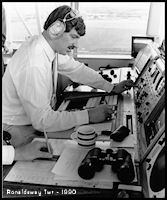 Aerodrome Control
- 1990
Aerodrome Control
- 1990
|
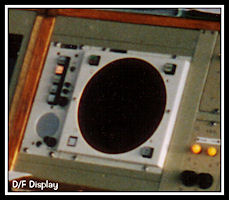 Fernau large DRDF
display
Fernau large DRDF
display
|
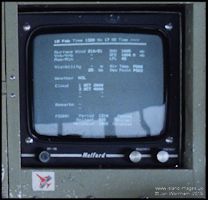 CCTV with METAR Observations
CCTV with METAR Observations
|
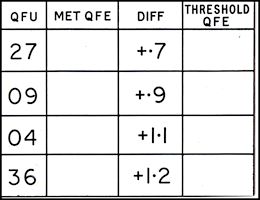 Card for calculating
QFE Threshold
Card for calculating
QFE Threshold
|
Control techniques remained
much the same as had been established with the arrival of radar in 1966.
In Approach there was generally both an 'Approach Procedural' and 'Approach
Radar' controller, with an Air Traffic Control Assistant taking estimates
on inbound aircraft and annotating the Flight Progress Strips. All arrivals
and departures were individually co-ordinated with Manchester Centre by
the Approach Procedural controller, who would then pass the flight progress
strip to the Approach Radar controller if vectoring or radar separation
was required.
An '8 mile check' on
inbound aircraft would be passed by intercom from radar to the Tower controller
upstairs as the only surveillance equipment Tower had were eyes, binoculars
and the radio direction finder! Many ATC towers were provided with a 'Distance
From Touchdown Indicator' (DFTI), a small daylight viewing CRT display
showing aircraft up to 10 miles around the airport, but at Ronaldsway,
if Tower wanted a range check on an inbound aircraft they had to ask Radar
on the intercom.
Traffic operating under
Visual Flight Rules (VFR) would be integrated with Instrument Flight Rules
(IFR) traffic either by the radar controller or by Tower, based on the
'8 mile check' and much searching through the windows! Integrating VFR
Circuit traffic was down to Tower. The Direction Finder was a great help
here in showing which direction to look out of the windows for your circuit
and VFR joining traffic.
The Airfield
in 1991
 Airfield Diagram
for 1991
Airfield Diagram
for 1991
|
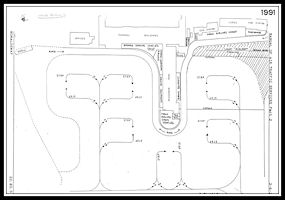 Apron Parking Stand
Layout 1991
Apron Parking Stand
Layout 1991
|
Airlines at Ronaldsway in the
1990s
At the start of the
decade most routes to and from Ronaldsway were covered by Manx Airlines,
with Jersey European operating on the
routes from Blackpool.
There was a summer Saturdays only service from Prestwick by Loganair and
freight services were operated
by Janes Aviation using
a Short 330. The overnight mail services were covered by one of Manx Airlines
three Short 360 aircraft, G-LEGS, G-ISLE or G-BKMX, converted in the evening
from passenger to freight configuration and back to passenger in the morning.
Other aircraft in the Manx Airlines fleet were three BAe ATPs, G-OATP,
G-UIET and G-PEEL and a single BAe 146-100 G-OJET. Jersey European
used mainly Short 360 aircraft but Fokker F27 and BAe146 aircraft were
also used. An air freight service was operated by Janes Aviation, using
a Short 330, with Avro 748s joining the fleet later.
 Manx Airlines BAe146-100
G-OJET
Manx Airlines BAe146-100
G-OJET
|
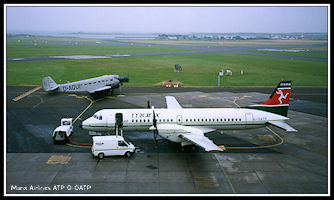 Manx Airlines BAe
ATP G-OATP
Manx Airlines BAe
ATP G-OATP
|
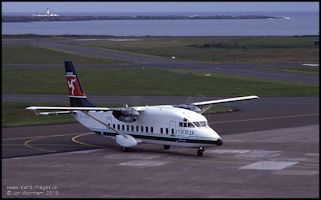 Manx Airlines Short
360 G-LEGS
Manx Airlines Short
360 G-LEGS
|
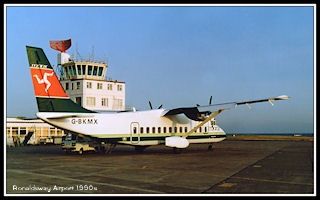 Manx Airlines Short
360 G-BKMX
Manx Airlines Short
360 G-BKMX
|
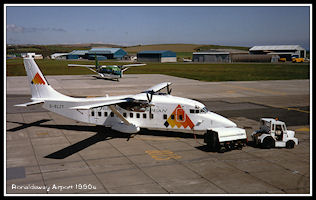 Jersey European Short
360 G-BLZT
Jersey European Short
360 G-BLZT
|
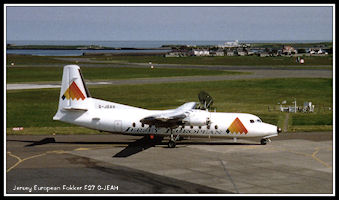 Jersey European Fokker
F27 G-JEAH
Jersey European Fokker
F27 G-JEAH
|
Charter flights were
operated from Ronaldsway by various companies, although flights to Malta
by Air Malta and Cyprus by Eurocypria were regular during the summer season.
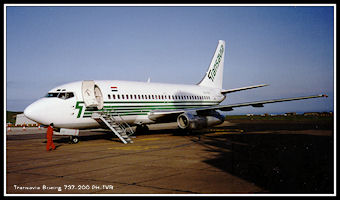 Transavia Boeing
737-200 PH-TVR
Transavia Boeing
737-200 PH-TVR
|
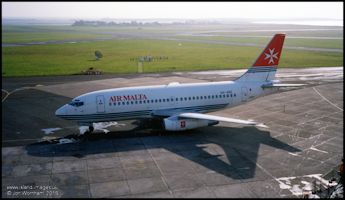 Air Malta Boeing
737-200 9H-ABE
Air Malta Boeing
737-200 9H-ABE
|
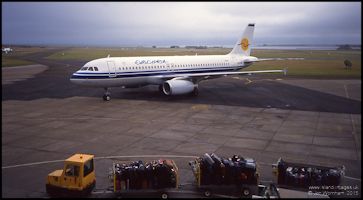 Eurocypria Airbus
A320 5B-DBB
Eurocypria Airbus
A320 5B-DBB
|
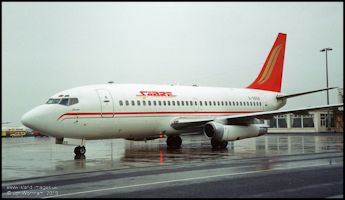 Sabre Airlines Boeing
737-200 G-SBEB
Sabre Airlines Boeing
737-200 G-SBEB
|
|
|
Radar Procedures
When I started at Ronaldsway
there were two 'standard' approaches offered to inbound aircraft. For runway
27 it was radar vectors for the Instrument Landing System (ILS) but for
runway 09 it was radar vectors for a Surveillance Radar Approach (SRA).
As has been mentioned before, providing an SRA is quite a time consuming
and time critical operation, so with an inbound 'rush' on 09 operations
radar would be very busy, if possible splitting off to discrete frequency
118.2 leaving the approach controller operating on 120.85 and providing
initial procedural separation before the radar controller was ready to
take another aircraft. Usually it was quite possible to vector a couple
of aircraft towards final whilst providing the SRA to the number one. For
some reason, we never seemed to work with Radar 1 & Radar 2 positions
open and no Approach procedural controller, it would have evened up the
workload more.
It became somewhat harder
in conditions of moderate to heavy rain. The radar was still Primary only,
i.e. no SSR labels to show which 'blip' was which aircraft with each one
needing identification before vectoring. The radar was subject to becoming
swamped by weather returns, despite the best efforts of the controller
to suppress it using circular polarization and other processing devices
available on the radar control panel. It was indeed always possible to
remove all of the weather returns from the display, unfortunately this
usually also removed the aircraft returns! In really bad conditions the
controller would use an electronic marker on the display, moved by 'x'
and 'y' axis potentiometers, to retain the identity of an aircraft blip
through areas of heavy weather clutter, but sometimes you just had to admit
defeat, terminate the radar service and operate procedurally.
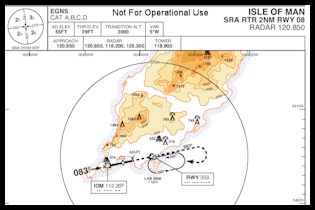 Surveillance Radar
Approach Chart, Runway 08
Surveillance Radar
Approach Chart, Runway 08
|
 Radio Phraseology
for Surveillance Radar Approach
(Click for full page)
Radio Phraseology
for Surveillance Radar Approach
(Click for full page)
|
Towards the latter part
of the decade, after some pilots suggesting that they actually preferred
the alternative NDB/DME or VOR/DME approaches available to runway 09, routine
SRAs were discontinued, considerably reducing the workload of the radar
controller in busy periods, SRAs were still of course available on request.
Services Outside Controlled
Airspace
Whilst the main purpose
of Ronaldsway ATC unit was to provide services for aircraft inbound to
or outbound from Ronaldsway, a range of services were provided to other
aircraft outside controlled airspace. An organised Lower Airspace Radar
Service (LARS) had been established in the early 1970s using spare capacity
of military airfield radar units to provide a service outside controlled
airspace up to Flight Level 95. Later, some civil units were invited to
join and Ronaldsway, filling an obvious gap over the northern Irish Sea,
participated. A small annual sum of money was paid to the unit for providing
LARS.
Services provided were
either a Radar Advisory Service (RAS) or Radar Information Service (RIS).
Under a Radar Advisory Service, aircraft would be identified and informed
of other traffic observed on radar that was likely to pass close to their
track. Advisory headings would be given with the intention of providing
standard separation from the other traffic. If the other traffic was working
Ronaldsway or co-ordinated with another unit this was quite easy, but many
tracks would be unidentified with unknown intentions (often military fast
jet traffic operating down to low levels) which could make life a little
difficult! Ronaldsway had no Secondary Radar to give height information.
Under a Radar Information Service, traffic information was offered to participating
aircraft, but no advisory headings offered, it was up to the pilot to use
the information to visually identify the other traffic and take appropriate
avoiding action using the Rules of the Air for guidance as to who had 'right
of way'.
Eventually, a review
of LARS services was undertaken and the finance to Ronaldsway was withdrawn,
the unit also vanishing from the LARS map published in various documents.
In practice this made no difference to the service provided, aircraft passing
by were still provided with a RIS or RAS subject to unit capacity, e.g.
if a single controller was providing a series of SRAs to inbound traffic,
it was unlikely the RIS or RAS would be available,
1991 Changes to Airspace Classifications
In November 1991 the
UK adopted a new system for airspace classifications developed by the International
Civil Aviation Organisation (ICAO). This re-classified all UK airspace
into classes from A to G, Class A being the most restrictive to Class G
being totally uncontrolled. The UK Airways system became Class A airspace,
with no VFR flight permitted whilst the Isle of Man Control Zone and Control
Areas became Class D. The Advisory Routes became Class F. In class D airspace,
all flights required a Flight Plan to be submitted to ATC and a clearance
obtained before entering the airspace. The Flight Plan could be either
a full plan covering the entire flight, or abbreviated information just
relevant to the portion within class D airspace. A full flight plan was
transmitted to the destination airfield and en-route ATC agencies and for
'off airways' flights, a departure message was sent, enabling overdue action
to be initiated if the aircraft failed to arrive at its destination within
certain time parameters.
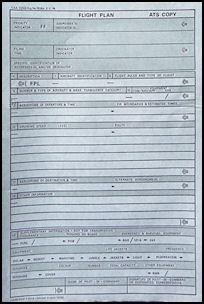
|
UK Flight Plan Form
(CA48)
Used by pilots to submit
a 'full' flight plan to ATC, covering the flight from point of departure
to destination. An abbreviated plan could be submitted by phone 'booking
out' if departing the airfield, or by radio for inbound or transit flights.
|
Whilst within Class
D airspace, pilots had to maintain a listening watch on the appropriate
radio frequency and obey ATC instructions. Flights operating under Instrument
Flight Rules (IFR) were to be separated from each other by ATC and provided
with traffic information on VFR flights. Flights operating under the Visual
Flight Rules (VFR) were to be provided with information on pertinent traffic,
pilots being responsible for avoiding other aircraft in accordance with
the Rules of the Air.
|
Table of UK Airspace
Classifications
This table is dated
later than the initial introduction of ICAO airspace classification and
includes subsequent changes to air traffic services provided.
|
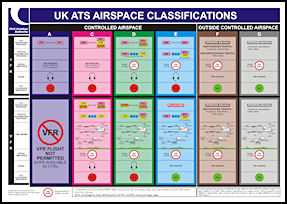
|
ATC at Jurby Airfield - early
1990s
In the early 1990s there
were still regular Royal Air Force Association (RAFA) airshows held during
the summer at the former RAF Jurby. ATC facilities were provided by ATCOs
normally working at Ronaldsway but on a fairly basic level, Tower control
only. ATC equipment would have consisted mainly of a VHF radio station,
clock and flight progress strips. I never made it to Jurby for these early
shows but was often on duty at Ronaldsway which is where any fast jet participants
would be based. Ronaldsway ATC would also be very busy with visiting aircraft
transiting to and from the show. The airshow didn't last very long into
the 1990s but was revived in 1996 to include air racing - see below
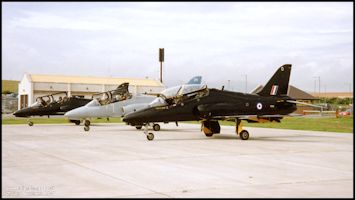 3 RAF Hawks at Ronaldsway
for the Jurby show
3 RAF Hawks at Ronaldsway
for the Jurby show
|
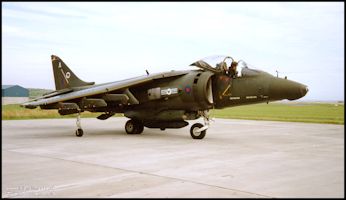 RAF Harrier GR5 ZD322
for the Jurby show
RAF Harrier GR5 ZD322
for the Jurby show
|
Jurby airfield was also
active at various times during the 1990s for military exercises. The RAF
would usually provide a forward base ATC controller for the various aircraft
using the airfield which included C130 Hercules, Chinook, Lynx and other
helicopters. Civil ATC involvement was fairly minimal with some aircraft
transiting Ronaldsway's controlled airspace but most of the operations
had no effect. During the exercises, Jurby was often used for night operations
using Night Vision Goggles and very little lighting at the airfield.
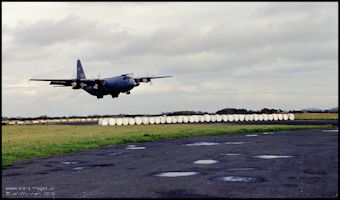 RAF C130K Hercules
XV300 on final at Jurby
RAF C130K Hercules
XV300 on final at Jurby
|
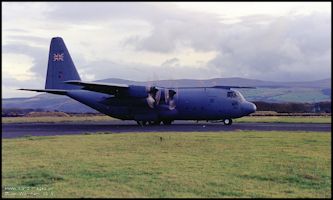 RAF C130K Hercules
XV300 on runway 26 at Jurby
RAF C130K Hercules
XV300 on runway 26 at Jurby
|
Manx Airlines Europe
In March 1991 the Manx
Airlines company was split into two operations when an operation based
on Cardiff Wales airport was opened. Manx Airlines (IOM) continued the
Isle of Man operation and Manx Airlines (Europe) handled the Cardiff base.
Initial equipment was two BAe Jetstream 31s, G-GLAM and G-WENT but in March
1993 the first of the larger Jetstream 41s, G-WAWR was delivered, closely
followed by G-WAWL, G-WAYR, G-WAND and G-WAFT. Whilst not normally
operating services from Ronaldsway initially, they visited on a regular
basis for maintenance, usually arriving after normal airport closing time
on a Friday evening, thus establishing the 'temporary' Friday evening hours
extension which continued for many years. They would depart again on Sunday
for the following week's services from Cardiff.
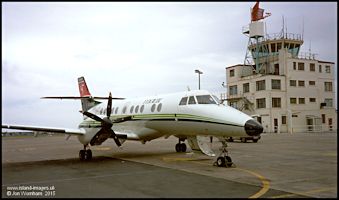 Manx Airlines (Europe)
Jetstream 41 G-WAWR
Manx Airlines (Europe)
Jetstream 41 G-WAWR
|
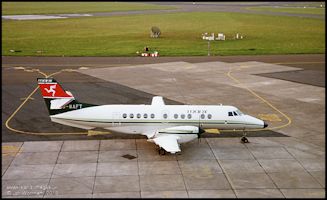 Manx Airlines (Europe)
Jetstream 41 G-WAFT
Manx Airlines (Europe)
Jetstream 41 G-WAFT
|
Changes to Controlled Airspace
By 1994 there were some
changes to the controlled airspace around the Isle of Man. The main airway
passing over the island had been renamed 'Blue Three', the name changing
to 'Bravo Three' with the dropping of the colour code system for naming
airways. The Advisory Route (ADR) from Blackpool to Carnane had been abolished
and the ADR from Pole Hill to Carnane re-routed to the 'IOM' VOR/DME and
renamed 'Whiskey Two Delta', thus all airways routes over the island now
went via the 'IOM'. The Eskmeals gunnery Danger Area 'D406' had expanded
once more with the addition of 'D406C', coming much closer to the Isle
of Man. This required the eastern extremity of the Isle of Man Control
Zone to be reduced in size to provide a 'free lane' of uncontrolled airspace
between the zone and danger area. In compensation an extra fillet of Control
Area to the south east was provided, making vectoring for the runway 27
ILS easier.
The 'free lane' was
heavily used by military aircraft in transit to and from the bombing range
at RAF Jurby Head, commonly USAF F111 aircraft at medium to low altitudes,
but as the aircraft never contacted Ronaldsway ATC (USAF aircraft were
unable to as they had no VHF radios), it was difficult to pass any meaningful
traffic information to aircraft inbound to or departing the Control Zone.
Ronaldsway radar could see the 'blips' of the range aircraft but had no
way of determining altitude. When the Jurby Range closed in 1993
the problem was resolved.
Four new Reporting points
were established for Ronaldsway's use, with holds being published for SLYDA,
VANIN and KELLY. With the Carnane NDB no longer required for en-route traffic,
ownership was transferred from the CAA to the Isle of Man Government as
it was very useful to Ronaldsway for holding training traffic and almost
essential to avoid delays when operating without radar,
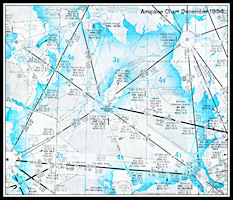 Northern Irish Sea
Airways Chart - 1994
Northern Irish Sea
Airways Chart - 1994
|
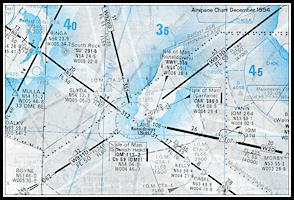 Isle of Man area
Airways Chart - 1994
Isle of Man area
Airways Chart - 1994
|
Air Freight and Mail Services
In 1993 Janes was renamed
Emerald Airways and started to expand their fleet with Avro 748s acquired
from various other operators. Emerald had their own colour scheme but may
of the aircraft were painted to represent customers. Some remained
more or less in the colours of their previous operators. At one time there
were three Emerald 748s arriving soon after airport opening time, one with
the mail and two general freighters. As the aircraft then day stopped at
Ronaldsway before departing again in the evening, Emerald carried out a
lot of their pilot training at Ronaldsway, indeed ATC had two standard
training flight profiles and the training captain just had to ring up,
give a departure time and profile to be flown.
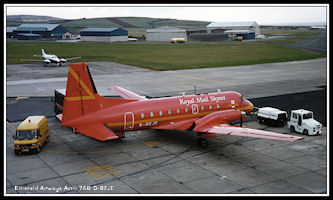 Emerald Airways Avro
748 G-BEJE
Emerald Airways Avro
748 G-BEJE
|
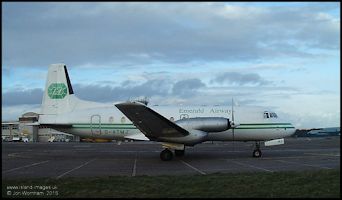 Emerald Airways Avro
748 G-ATMJ
Emerald Airways Avro
748 G-ATMJ
|
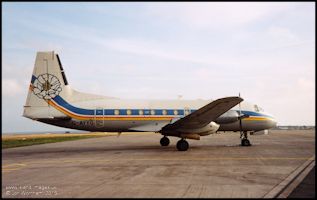 Emerald Airways Avro
748 G-AYYG
Emerald Airways Avro
748 G-AYYG
|
 Emerald Airways Avro
748 G-BVOU
Emerald Airways Avro
748 G-BVOU
|
The mail contract came
up for renewal on a regular basis and there was stiff competition between
airlines to win it. At various time during the 1990s it was operated by
Manx Airlines, Gill Air, BAC Express and Emerald.
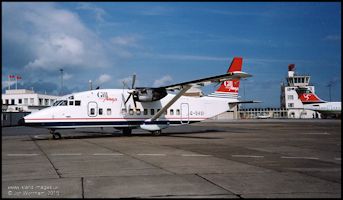 Gill Airways Short
360 G-DASI
Gill Airways Short
360 G-DASI
|
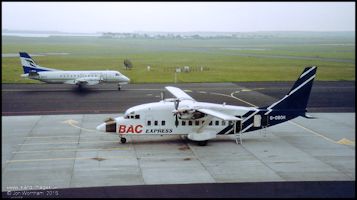 BAC Express Short
360 G-OBOH
BAC Express Short
360 G-OBOH
|
Comed Aviation
Blackpool based Comed
Aviation started services linking Blackpool, the Isle of Man and Belfast
in the early 1990s Initially using 9 seat Piper Navajo aircraft, they expanded
with the 19 seat Embraer Bandeirante
 Comed Aviation Bandeirante
G-OBPL
Comed Aviation Bandeirante
G-OBPL
|
New BAe 146s for Manx Airlines
In March 1993 a new
146 arrived fro Manx Airlines. This was 200 series G-MIMA which was to
give excellent service on the London Heathrow (later Gatwick) route for
many years until sold in 2005. In May 1994 another 200 series was acquired,
this was G-MANS and primarily to be used on Manx Airlines Europe services
from Belfast City.
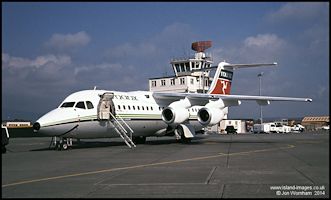 Manx Airlines BAe
146-200 G-MIMA
Manx Airlines BAe
146-200 G-MIMA
|
 Manx Airlines BAe
146-200 G-MANS
Manx Airlines BAe
146-200 G-MANS
|
New Denro Communications System
Installed
In the early 1990s the
largely 'home made' radio and telephone communications system in use was
badly in need of replacement and a system manufactured by the Denro company
of the USA was selected. This was a major improvement over the previous
system using miniature illuminated buttons for control of radio frequencies
and telephones. Headsets, which had not previously been widely used at
Ronaldsway, were required at controller positions. Unfortunately the system
displayed some major operational shortcomings which made it unsuitable
for ATC and had to be replaced before the end of the decade.
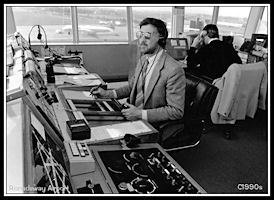 Ronaldsway Tower
with 'Denro' Communications
Ronaldsway Tower
with 'Denro' Communications
|
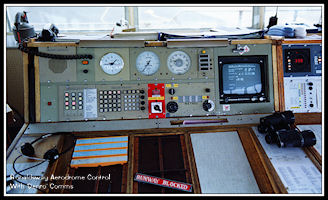 Tower Control Desk
with 'Denro' Comms
Tower Control Desk
with 'Denro' Comms
|
Airfield Lighting Controls Updated
Also in need of replacement
in the 1990s was the airfield lighting control system. At the start of
the decade the lights were operated from a large panel to the left of the
tower controller's position. Lights were selected using large metal 'up
and over' switches with intensities varied by circular controls. Runway
in use was selected by a central 'QFU' switch. As the airfield lighting
had changed over the years, extra switch panels had been added which made
lighting selection somewhat complicated. The system was replaced by a smaller
'push button' panel initially installed in a wooden cabinet. Provision
was incorporated for taxiway 'stop-bars' although they were not to be installed
on the airfield until after this panel had been replaced.
 Lighting Control
panel at the start of the 1990s
Lighting Control
panel at the start of the 1990s
|
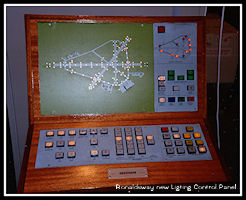 Replacement Lighting
Panel on test
Replacement Lighting
Panel on test
|
The Teleprinter section closed
and Flight Briefing Office Established
During the first half
of the decade, the Teleprinter section on the ground floor of the control
tower was closed. The airport telephone exchange was updated and moved
to the information desk located in the newly extended terminal building.
The teleprinters moved initially to a new Flight Briefing office making
use of a corner in the Met Office on the first floor. The Specialist Teleprinter
Operators retrained as ATC Assistants and the assistants learned how to
operate the teleprinters, ATSAs manning both ATC and the Briefing Office.
With the introduction of more modern computer systems for sending signals
over the Aeronautical Fixed Telecommunications Network, the Briefing Office
was moved 'landside', occupying three different locations in the terminal
building before eventually being closed down and all staff relocating to
the control tower.
Two views of
the Visual Control room with the original 1960s Control Desks - pictures
taken early 1995
Military Aircraft at Ronaldsway
in the 1990s
Military aircraft were
frequent visitors to Ronaldsway, the RAF Hawk T1 jet trainers from RAF
Valley in Anglesey on an almost daily basis as Ronaldsway was often their
nominated diversion airfield if they were unable to land back at Valley
for any reason. The Search and Rescue Westland Wessex helicopters would
visit regularly for refuelling, changing over the the Westland Sea Kings
during the decade. Army Air Corps fixed wing Islanders and helicopters
would also stop at Ronaldsway regularly. During the TT period, the RAF
Red Arrows Hawk aircraft would be based at Ronaldsway for displays at Douglas,
Peel and Ramsey, also operating out of Ronaldsway for displays in Northern
Ireland.
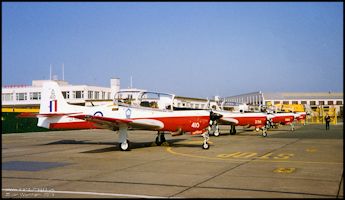 RAF Tucano T1 ZF410
+ 3
RAF Tucano T1 ZF410
+ 3
|
 French Navy
Falcon 10 32
French Navy
Falcon 10 32
|
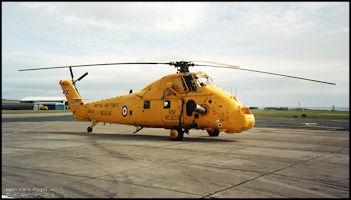 RAF Search &
Rescue Wessex XR520
RAF Search &
Rescue Wessex XR520
|
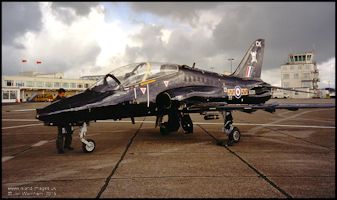 RAF Hawk T1A XX331
RAF Hawk T1A XX331
|
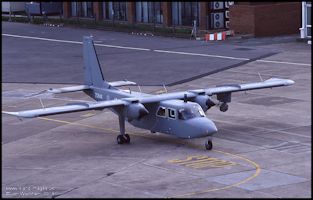 Army Air Corps BN
Islander AL1 ZG844
Army Air Corps BN
Islander AL1 ZG844
|
 Royal Navy Sea King
ZD633
Royal Navy Sea King
ZD633
|
More ATPs & Jetstream 41s
from Loganair
In 1994 Manx Airlines
took over several routes from Scottish operator Loganair, who were also
part of the Airlines of Britain group. These came with 8 BAe ATPs and 3
Jetstream 41s, which initially continued in Loganair colour scheme but
with 'Manx' titles and were a common sight at Ronaldsway. Eventually they
were all pained in Manx Airlines colours and the whole fleet was re-registered,
the ATPs in the G-MANA series and the Jetstream 41s in the G-MAJA series.
This included the original Manx Airlines aircraft.
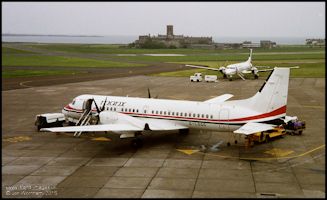 Former Loganair ATP
G-LOGG
Former Loganair ATP
G-LOGG
|
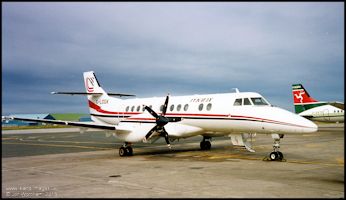 Former Loganair Jetstream
41 G-LOGK
Former Loganair Jetstream
41 G-LOGK
|
Saab 340s on the Glasgow Route
For a while the route
between the Isle of Man and Glasgow was operated by Business Air on behalf
of Manx Airlines, but often the aircraft used were from Swedish company
Skyways, who operated on some routes for Business Air
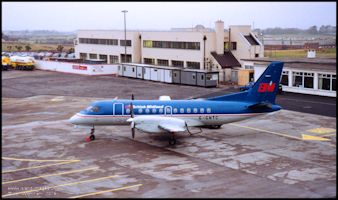 Business Air Saab
340 G-GNTC
Business Air Saab
340 G-GNTC
|
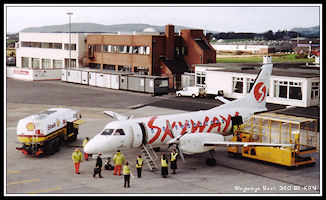 Skyways Saab 340
SE-KRN
Skyways Saab 340
SE-KRN
|
Knight Air
Knight Air operated
services between Leeds Bradford Airport and Ronaldsway in the mid 1990s
using Embraer Bandeirante Aircraft. After a fatal crash involving one of
their aircraft in May 1995 they withdrew from the airline business to concentrate
on pilot training and aircraft maintenance.
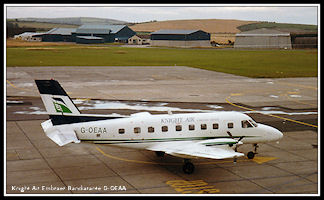 Knight Air Bandeirante
G-OEAA
Knight Air Bandeirante
G-OEAA
|
New Radar, colour radar displays
and new Tower Desk
By late 1994 the original
Plessey AR-1/AR-15 was becoming obsolete and costing more to maintain,
so it was decided to replace it with a completely new system. Two potential
products were considered for the radar and two for the new displays required.
For the Primary Radar the choice was between the Marconi S511 and the Plessey
Watchman, both 10 cm radars. For the displays, the contenders were colour
CRT systems supplied by Norcontrol and Flight Refuelling Ltd (FRL). Visits
were made by ATC control and engineering staff to Leeds/Bradford and to
Newcastle to compare the systems in use at those airports and the decision
was made to order the Plessey Watchman Primary Surveillance Radar (PSR)
together with the FRL colour displays. Consideration was made over ordering
a Secondary Surveillance Radar (SSR) system to be installed at the same
time but finance was not available and it was decided that SSR would be
installed at a later date. Included in the FRL display system was an Aerodrome
Traffic Monitor (ATM), for the first time at Ronaldsway the tower controller
would be able to see the location of aircraft in the vicinity of the airfield
that were not visible through the windows.
Ronaldsway ATC Visit
to Leeds/Bradford & Newcastle in 1994
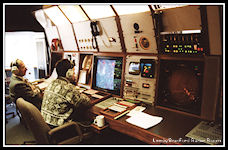 Leeds/Bradford
Leeds/Bradford
|
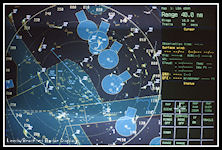 Leeds/Bradford
Leeds/Bradford
|
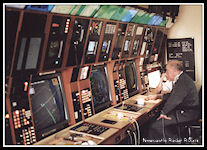 Newcastle
Newcastle
|
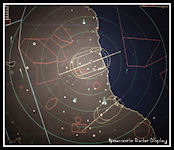 Newcastle
Newcastle
|
In 1995 the new radar
was shipped to and installed at Ronaldsway. A new site for the radar aerial
and transmit/receive equipment was selected on the south side of the airport
adjacent to the fire station and a metal gantry erected to support the
radar scanner aerial. The radar information was transferred to the control
tower building and a new radar control panel installed on top of the 1980s
metal radar desks. It proved just possible to shoehorn the large Barco
colour displays into the old desk, mounted on wheeled trolleys to facilitate
maintenance. The radar came into operation very quickly, being installed
between March and April 1995 with flight trials on two days in May before
being brought into operation ahead of schedule by the start of June.
 Plessey Watchman
Primary Radar Aerial
Plessey Watchman
Primary Radar Aerial
|
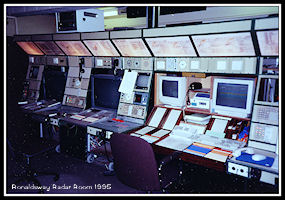 Barco/FRL Colour
Radar Displays Installed
Barco/FRL Colour
Radar Displays Installed
|
Pictures taken during
the commissioning trials of the Watchman PSR
 Watchman/FRL Radar
Picture
Unprocessed Video
Watchman/FRL Radar
Picture
Unprocessed Video
|
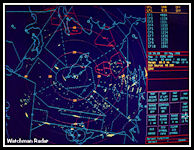 Watchman FRL Radar
Picture
Normal Mode
Watchman FRL Radar
Picture
Normal Mode
|
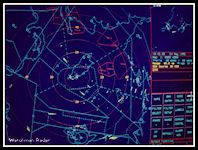 Watchman/FRL Radar
Picture
NR Inhibit Mode
Watchman/FRL Radar
Picture
NR Inhibit Mode
|
In the Visual Control
Room, the wooden desks dating from 1960 were totally unsuitable for accommodating
all of the new equipment coming into use and so were replaced by a new
design of metal desk, seating the Tower controller and assistant alongside
each other for the first time. The new desks were supplied by the manufacturer
as a kit of self assembly parts (flat pack ATC!) and were constructed in
the VCR whilst normal ATC operations carried on from what remained of the
old wooden desks.
VCR Reconstruction
in 1995
The new Tower
Desk in use
The Watchman radar had
been installed and commissioned in the nick of time. Just before the busy
1995 TT race week, the gearbox of the Plessey AR-1 radar failed completely.
Fortunately, all of the flight testing of the new radar had been completed
and with the help of the UK CAA the paperwork for the new system was rushed
though and controllers issued with dispensations for a month to operate
the new equipment pending formal validations. Without the radar in service
it would have been impossible to handle the traffic and probably would
have resulted in Ronaldsway being closed to private aircraft movements
for the duration of the TT. The new colour radar displays were in fact
very easy to use and the Watchman radar itself needed far fewer controller
adjustments than the old AR-1 to maintain a good picture. Actual ATC operating
procedures remained the same as before with aircraft needing radar identification
by turn, position or handover method. When radar passed the '8 mile check'
to tower, the aerodrome controller was now able to monitor the progress
of aircraft using the ATM, integrating visual circuit traffic with inbound
IFR aircraft had suddenly become a whole lot easier!
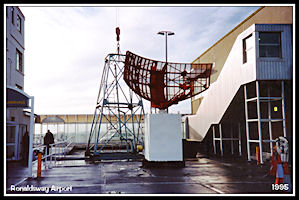
|
The AR-1 Aerial Removed
Pictured after being
lifted off the control tower
|
Air Traffic Control on a TT
Race Day
On four days of each
year ATC was totally transformed as vast numbers of spectators arrived
to watch the TT races. Airlines put on extra services, charter flights
arrived, but the biggest headache for ATC were the hundreds of light aircraft
that would try to arrive at Ronaldsway over a short space of time. There
was no ATC flow control measures and pilots arrived when it suited them,
which was generally in a very narrow 'window' of about three to four hours.
A large number of the
pilots seemed to be low hours private pilots who didn't really understand
how air traffic control worked and most of them didn't bother to file a
Flight Plan so ATC had no prior knowledge of flight details. Approach Radar
Control would be staffed by three ATCOs and one ATSA. Before Secondary
Radar was installed in 1998 the first indications of the arriving hordes
would be numerous primary radar blips observed heading towards the island
from England and Wales, light aircraft from Northern Ireland (a large percentage
of the total) would normally by flying low and beneath our radar coverage
in that direction. Some pilots would call on the radio up to 60 miles away,
some wouldn't bother until approaching the Control Zone!
The Approach Procedural
Controller would try and get the flight details of each aircraft as it
called and between him and the assistant write out flight progress strips.
The approach assistant would pass details to the tower assistant. Leaning
over the adjacent radar display, the approach controller would attempt
to identify each aircraft before transferring control to the Radar One
controller. Radar One would then clear the aircraft into the zone, pass
traffic information on other aircraft close by and try and stream the aircraft
into some sort of landing order. As the aircraft came within about 15 miles
of the airfield he would transfer control to the Radar Two controller who
would attempt to sequence the aircraft into a final landing order and integrate
with the scheduled and charter flights arriving via the airways system.
As there were no 'standing agreements' with Area Control, each airways
arrival had to be individually co-ordinated and released by phone between
the Radar One controller and the area controller at Manchester Centre.
Also the Radar Two Controller had to telephone Tower every few minutes
to pass the landing order of aircraft.
The Procedural Approach
position was easily swamped by numerous aircraft calling and trying to
pass their details and on one year the whole ATC system effectively broke
down for a while and airways traffic was held off or prevented from departing
whilst Ronaldsway tried to sort out who was where and clear them into the
zone. In following years, flow control measures were introduced and Flight
Plans strongly advised! Once Secondary Radar was available at Ronaldsway
from 1998 things became somewhat simpler, although the flow control was
still needed to avoid bunching of arriving aircraft.
 A typical TT Race
Day at Ronaldsway
A typical TT Race
Day at Ronaldsway
|
1995 - The British Airways franchise
starts
From January 1995 Manx
Airlines Europe became a British Airways franchise operation. Whilst this
did not directly affect the Manx Airlines (IOM) services in terms of day
to day operations, aircraft started to be re-liveried into BA colours although
with an 'Operated by Manx Airlines Europe' sticker prominently displayed
on the nose. BA liveried aircraft would operate on the Isle of Man routes
to cover non availability of the Manx Airlines Aircraft.
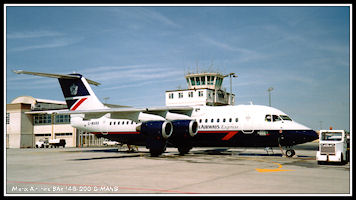 Manx Airlines (Europe)
BAe 146-200 G-MANS
Manx Airlines (Europe)
BAe 146-200 G-MANS
|
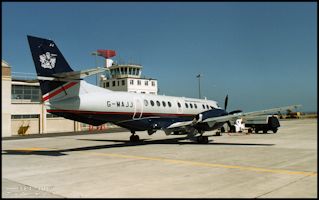 Manx Airlines (Europe)
BAe Jetstream 41 G-MAJJ
Manx Airlines (Europe)
BAe Jetstream 41 G-MAJJ
|
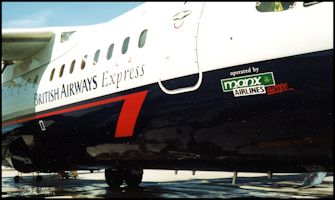 Manx Airlines Europe
logo on G-MANS
Manx Airlines Europe
logo on G-MANS
|
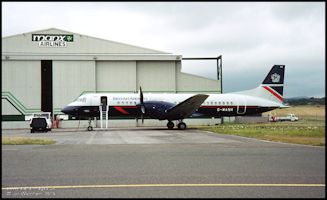 Manx Airlines (Europe)
BAe ATP G-MANH
Manx Airlines (Europe)
BAe ATP G-MANH
|
1996 - Emerald Airways Passenger
Services
Emerald Airways started
to operate passenger services on the popular Liverpool route from Ronaldsway
in direct competition with Manx Airlines on the 29th April, using some
of the newer Avro 748 airframes in the fleet. The passenger services were
finally stopped in March 1999 and Emerald reverted to operating only freight
services until recommencing Isle of Man passenger services in 2004.
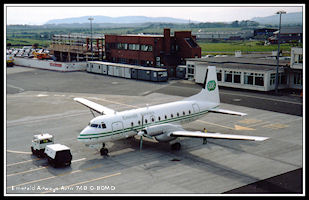 Emerald Airways Avro
748 G-BGMO
Emerald Airways Avro
748 G-BGMO
|
 Emerald Airways Avro
748 G-EMRD
Emerald Airways Avro
748 G-EMRD
|
1996 - British Regional Airlines
formed
In 1996 Manx Airlines
bought Aberdeen based Business Air and then later merged with Loganair
to form British Regional Airlines, operating under the British Airways
franchise agreement. This brought Saab 340s and another 146 into the fleet
from Business Air and Islanders, Short 360s (some ex Manx Airlines) and
a Twin Otter from Loganair. Manx Airlines continued to operate as a separate
company under the overall BRAL leadership. After a short period of time
it was decided that Scottish islands services of Loganair would operate
more efficiently as a separate concern and following a management buyout
they separated from the BRAL group in March 1997 although continuing as
a BA franchise operator.
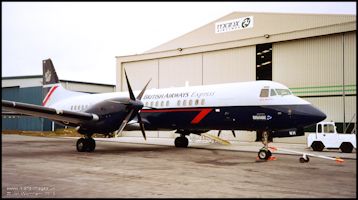 British Regional
Airlines BAe ATP G-MANH
British Regional
Airlines BAe ATP G-MANH
|
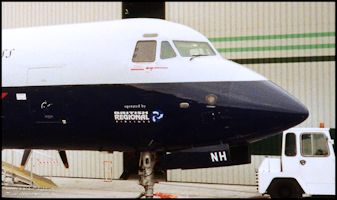 British Regional
Airlines logo on G-MANH
British Regional
Airlines logo on G-MANH
|
As a result of
the various associations between Loganair and Manx Airlines, aircraft moved
in both directions between companies, resulting in some ex Manx Airlines
aircraft operating with Loganair. The Short 360 was even operated on the
route from Glasgow to the beach airfield at Barra. It was not a success,
often being cancelled and the route eventually reverted to Twin Otter operation,
much to the relief of the Barra inhabitants.
 Loganair Short 360
G-WACK
Loganair Short 360
G-WACK
|
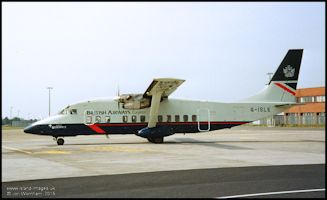 Loganair Short 360
G-ISLE
Loganair Short 360
G-ISLE
|
ATC at Jurby - 1996
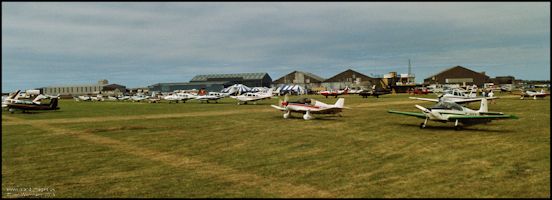 In 1996 the Jurby Airshow
was resurrected, as a three day event to include traditional air racing,
initially to the island from the UK on the Friday and then local air races
on the Saturday morning with an airshow on Saturday and Sunday afternoon.
On the Friday, ATCOs from Ronaldsway provided an Air Ground Radio service
(very difficult to remember no to clear aircraft to land or take-off!)
but for the airshow days an Aerodrome service was provided. ATC facilities
were very basic, with a table provided in the otherwise empty control tower
to accommodate a flight progress strip display, VHF radio for ground to
air communication and UHF radio for communicating with the fire and rescue
service. On the first day the VHF base station and aerial combination proved
to have a range of about 2 miles from the airfield and was replaced by
a hand held transceiver linked to an aerial designed for use on a vehicle
but magnetic mounted on the railings above the control room, on which we
found that we could talk to aircraft crossing the Cumbrian coast! For the
airshow days the problems were resolved and we were able to use the proper
base station. Other equipment comprised a clock, signalling lamp and a
very pistol which was mainly used for bird scaring but with a couple of
red and green cartridges for emergency use.
In 1996 the Jurby Airshow
was resurrected, as a three day event to include traditional air racing,
initially to the island from the UK on the Friday and then local air races
on the Saturday morning with an airshow on Saturday and Sunday afternoon.
On the Friday, ATCOs from Ronaldsway provided an Air Ground Radio service
(very difficult to remember no to clear aircraft to land or take-off!)
but for the airshow days an Aerodrome service was provided. ATC facilities
were very basic, with a table provided in the otherwise empty control tower
to accommodate a flight progress strip display, VHF radio for ground to
air communication and UHF radio for communicating with the fire and rescue
service. On the first day the VHF base station and aerial combination proved
to have a range of about 2 miles from the airfield and was replaced by
a hand held transceiver linked to an aerial designed for use on a vehicle
but magnetic mounted on the railings above the control room, on which we
found that we could talk to aircraft crossing the Cumbrian coast! For the
airshow days the problems were resolved and we were able to use the proper
base station. Other equipment comprised a clock, signalling lamp and a
very pistol which was mainly used for bird scaring but with a couple of
red and green cartridges for emergency use.
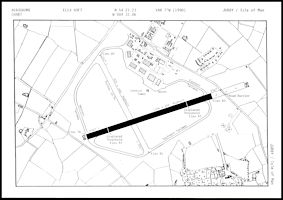 Jurby Aerodrome Chart
for 1996
Jurby Aerodrome Chart
for 1996
|
An Aerodrome Traffic
Zone was established when the ATC unit was NOTAMed as active, out to 1.5nm
from the airfield boundary up to 2000ft and any aircraft wishing to enter
had to contact Jurby Tower by radio. I believe that for this show we just
used one of Ronaldsway's allocated frequencies, so it would have been 125.3
or 118.2. A standard circuit pattern was used, at altitude 1000ft, left
hand on runway 26 and right hand on runway 08. This was purely to try and
keep aircraft within sight of ATC, as there were no windows in the rear
wall of the control room so any aircraft to the north of the airfield could
not be seen. Only an Aerodrome Control Service was provided, there
were no instrument approaches or radio aids available. Aircraft would
call up to join, be given the runway in use, circuit direction, QFE and
any relevant traffic information. A there was no anemometer installed st
Jurby, the wind speed would be assessed at regular intervals by the Met
observer from the roof of the tower. In theory, overhead joins should
have been the norm, but I think in practice aircraft joined the circuit
from the direction they arrived. Runway 16/34 was not available for
use as it was used for parking aircraft.
Normal ATC services
were suspended during the air races, an Air - Ground radio service being
provided (by the same controllers) instead. To facilitate this any
controller working at Jurby had a separate A/G Radio Operators certificate
in addition to the Jurby Tower validation on our ATCO licenses.
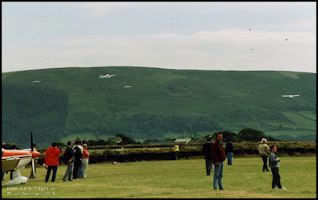 Air Racing at Jurby
Air Racing at Jurby
|
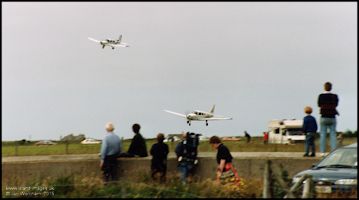 Air Racing at Jurby
Air Racing at Jurby
|
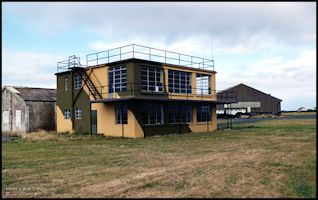 Jurby Control Tower
Jurby Control Tower
|
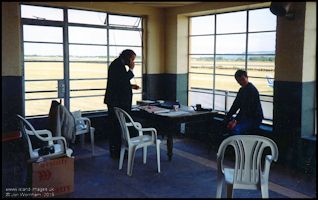 Jurby Air Traffic
Control - 1996
Jurby Air Traffic
Control - 1996
|
The racing and airshows
were very popular but were not to be repeated until the early 2000s
1997 - The Embraer 145s for
British Regional start to arrive at Ronaldsway
After evaluating several
options for new aircraft, British Regional Airlines opted for the 50 seat
Embraer ERJ145 and the first one arrived at Ronaldsway in June 1997 still
wearing its Brazilian flight test registration of PT-SYM as the type was
not yet certificated in the UK. By mid July the formalities had been completed
and it was re-registered as G-EMBA. This was probably the first aircraft
to be seen at Ronaldsway wearing one of the new British Airways 'World'
colour schemes and as each delivery up to G-EMBK arrived it was interesting
to see which variation it would carry. From G-EMBL all further aircraft
were panted in the BA 'Chatham' flag colour scheme. Each aircraft arrived
at Ronaldsway from Brazil via Portugal for commissioning before leaving
for a UK base. By the end of the decade, a total of 14 had arrived taking
registrations up to G-EMBN.
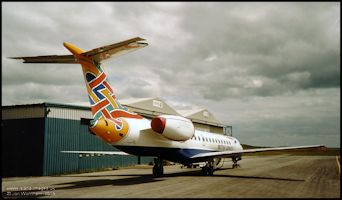 British Regional
Embraer ERJ145 PT-SYM
British Regional
Embraer ERJ145 PT-SYM
|
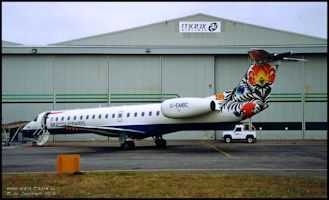 British Regional
Embraer ERJ145 G-EMBC
British Regional
Embraer ERJ145 G-EMBC
|
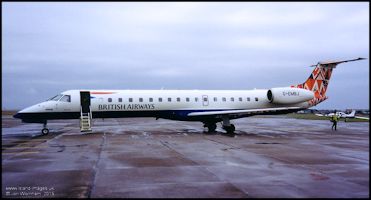 British Regional
Embraer ERJ145 G-EMBJ
British Regional
Embraer ERJ145 G-EMBJ
|
 British Regional
Embraer ERJ145 G-EMBL
British Regional
Embraer ERJ145 G-EMBL
|
Manx Airlines 15/50
In 1997 Manx Airlines
celebrated its 15 birthday and this co-incided with the 50th anniversary
of the original Manx Airlines being formed in 1947. There were various
celebrations and a special logo designed, although I seen to remember it
only appeared boldly on one aircraft, white liveried G-BUUP. There
was an airshow organised at Ronaldsway which took place on a Saturday afternoon,
when there were few scheduled airline movements. I don't seem to
have any pictures of the show despite being designated airshow Tower controller,
probably because I was suffering from a throat infection and only just
lasted through the show before retiring sick with no voice!
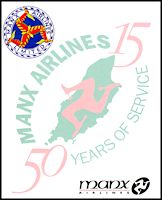 Manx Airlines 15/50
Logo
Manx Airlines 15/50
Logo
|
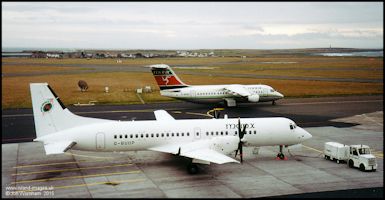 Manx Airlines ATP
G-BUUP with the 15/50 logo
Manx Airlines ATP
G-BUUP with the 15/50 logo
|
1998 - Secondary Surveillance
Radar Installed
In 1998 a Cossor Secondary
Surveillance Radar (SSR) system was added, introducing a second radar aerial
on top of the Watchman. Unlike Primary Radar that works by receiving reflected
radar energy pulses from 'targets', SSR works by interrogating radar transponders
fitted to aircraft. Each flight is allocated a unique four digit code from
a total pool of 4096 and the transponder responds to interrogation by ground
radars by returning the code (Mode Alpha), usually also with the aircraft's
level (Mode Charlie). This information is displayed alongside the primary
radar 'blip' on the radar display. Aircraft could now be identified by
the SSR return, removing the former laborious process of identifying each
aircraft on the PSR. Combined with the Code/Callsign conversion computer,
the aircraft radio callsigns were now shown on the radar display.
One of the major advantages
of SSR over just Primary radar was that the controller now no longer had
to remember which 'blip' was which aircraft and with the continuous 'Mode
C' height readout could anticipate the need for further descent of climb
clearances saving the airlines fuel wasting 'level offs' or pilots having
to ask over the radio. Without the SSR radio workload was considerably
increased when climbing or descending an aircraft through the level of
another with regular level checks being required, now the controller just
had to monitor the levels on the radar display. One other big advantage
was when providing radar services outside controlled airspace, if a potentially
conflicting aircraft was suitably equipped Ronaldsway could at last determine
its altitude or flight level and from the 'Squawk' code displayed know
which other ATC unit in the area was controlling it. With several very
busy high level routes passing the Isle of Man this could save on a lot
of unnecessary traffic information or avoiding action being passed.
Ronaldsway
Combined PSR/SSR Radar Aerials
Introduction of
SSR was a major advance and led to a reduction in the amount of co-ordination
between Radar and Tower, considerably cutting the number of telephone or
intercom calls needed. As the SSR information was also displayed in the
tower on the Aerodrome Traffic Monitor (ATM) the '8 mile checks' required
on all aircraft before could now be omitted in most cases.
With regulated fatigue
breaks now being mandated for controllers, staffing in the Radar room tended
to be just a radar controller and assistant, the third controller on watch
providing breaks for the other two whilst being available to open the 'Radar
Two' position if busy traffic or the need for Surveillance Radar Approaches
warranted it. The assistants also had other duties such as airfield inspections
and bird scaring, which meant that often the radar controller was working
on his own.
FRL Radar Display
with SSR
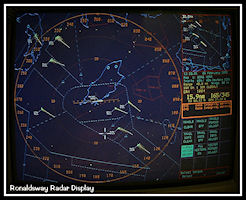 Radar Vectoring Configuration
Radar Vectoring Configuration
|
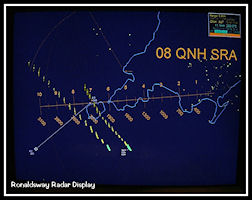 Surveillance Radar
Approach Configuration
Surveillance Radar
Approach Configuration
|
Changes on the Airfield
All airfield runways
are numbered according to the Magnetic Heading rounded to two digits. As
the magnetic variation changes over the years, at some point it becomes
necessary to change the runway designations and by 1998 when the chart
below was published, Ronaldsway's had all been renumbered. The east parking
apron apron had been expanded to produce two more stands and the overall
apron layout has also been changed to 'nose-in' parking. Aircraft now had
to be pushed back off stand by a tug, although most of Manx Airlines turboprops
were permitted to 'power-back' off the stand by using reverse thrust.
Eye protection and ear defenders being a pre-requisite for the ground staff
involved. Noise levels also rose somewhat inside the tower!
|
1998 Jeppesen Airfield
Diagram
Showing the new Runway
Designators & Stand Layout
|
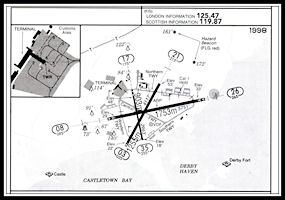
|
New Manx Airlines Livery Introduced
In 1998 a new livery
appeared on 146 G-MIMA, bearing some similarities to the British Airways
'World' liveries, but using a green and red ' 3 legs' design.
The three 'Manx' ATPs
(G-MANA, B, & C) and Jetstream 41 G-MAJA were subsequently all painted
in the scheme
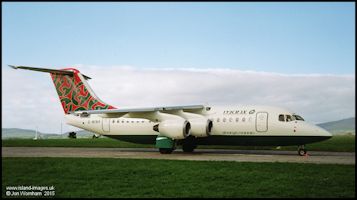 Manx Airlines BAe146-200
G-MIMA
Manx Airlines BAe146-200
G-MIMA
|
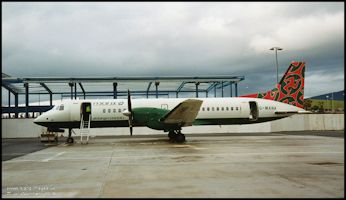 Manx Airlines BAe
ATP G-MANA
Manx Airlines BAe
ATP G-MANA
|
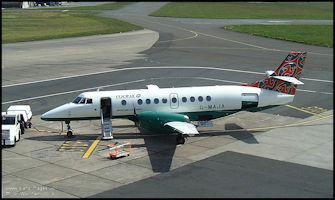 Manx Airlines BAe
Jetstream 41 G-MAJA
Manx Airlines BAe
Jetstream 41 G-MAJA
|
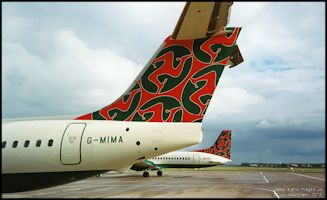 Manx Tails - G-MIMA
and G-MANC
Manx Tails - G-MIMA
and G-MANC
|
1999 - New aircraft for Jersey
European
Jersey European started
to update their fleet in 1999 with the arrival of the De-Havilland Canada
Dash8 turboprop. The first two aircraft in the fleet, 300 series G-JEDA
& G-JEDB came second hand but following aircraft were new 'Q' series
aircraft, comprising four Q300s, G-JEDC - DF and three of the smaller Q200s
G-JEDX - DZ. The gap in the registration sequence being filled by Q400s
from 2001 onwards.
 Jersey European Dash8
G-JEDA
Jersey European Dash8
G-JEDA
|
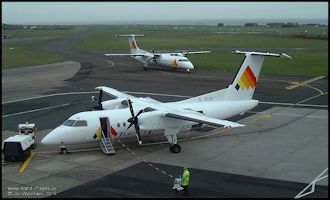 Jersey European Dash8s
G-JEDX & G-JEDE
Jersey European Dash8s
G-JEDX & G-JEDE
|
Frequentis Communications System
installed at Ronaldsway
The Denro communications
system that had been used since the early 1990s had proved unsatisfactory,
with control panel 'lockups' and radio frequencies being selected and de-selected
by the system without controller interaction. Attempts by the manufacturer
to resolve the issue had failed to achieve required objectives and so the
decision was taken to replace the whole system with a Frequentis design.
This used a touch screen panel to select telephone lines and radio frequencies
and proved highly satisfactory in service, only being replaced (by another
Frequentis system) with the move to the new control tower.

|
Frequentis Communications
Screen
Touch sensitive screen
for radio and telephone communications
|
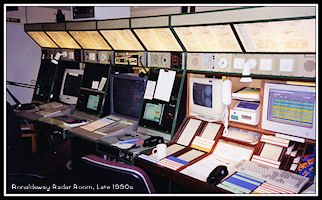 Radar Room with Frequentis
Comms
Radar Room with Frequentis
Comms
|
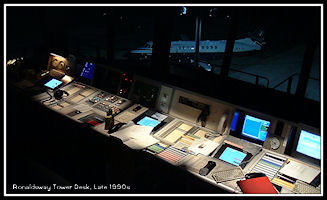 Tower Desk with Frequentis
Comms
Tower Desk with Frequentis
Comms
|
Jurby Remote Radio Station
In the mid 1990s it
had been identified that there was a problem with Ronaldsway communicating
with aircraft over the northern plain of the island and approaching the
Isle of Man control zone boundary from the north at lower levels. Towards
the end of the decade an attempt was made to resolve this by establishing
an experimental remote radio station at the Jurby airfield control tower.
Operating in conjunction with the main transmitter/receiver at Ronaldsway,
the relay station was selected via the Frequentis control panel in the
radar room, the intention being that both stations would normally be selected
to operate at the same time giving solid radio coverage all around the
island. For this purpose the Ronaldsway transmit frequency was offset to
120.855 MHz, Jurby operating on 120.850 Mhz to avoid mutual interference
from the two transmitters.
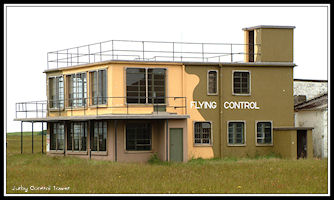 Jurby Control Tower
Jurby Control Tower
|
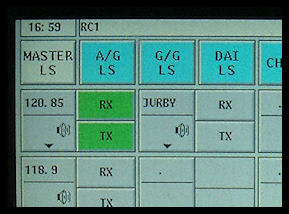 Jurby TX/RX Selector
on Comms Panel
Jurby TX/RX Selector
on Comms Panel
|
Whilst the station itself
was a success, giving excellent coverage over the north of the island,
some technical difficulties were found with certain individual aircraft
radio stations when both transmitters were operating together. This was
probably because the Jurby transmitter was an old piece of equipment and
not modified with a frequency offset (to 120.845) as with normal practice
when using a two transmitter ATC system. This combined with other
unforeseen issues over backup equipment and off-air radio recording demanded
by regulations caused the experiment to be abandoned due to increased costs
and the station was subsequently removed.
The 1990s had been a
decade of major change at Ronaldsway. At the start, little had changed
since the installation of radar in the 1960s and the unit a decidedly 'vintage'
look about it. At the end of the decade it was as modern as any, with a
new and reliable communications system, new Primary Radar and Secondary
Surveillance Radar system installed. Computer systems were processing Flight
Plans and providing aircraft callsign labels on the radar.
ATC
in the 2000s
|

